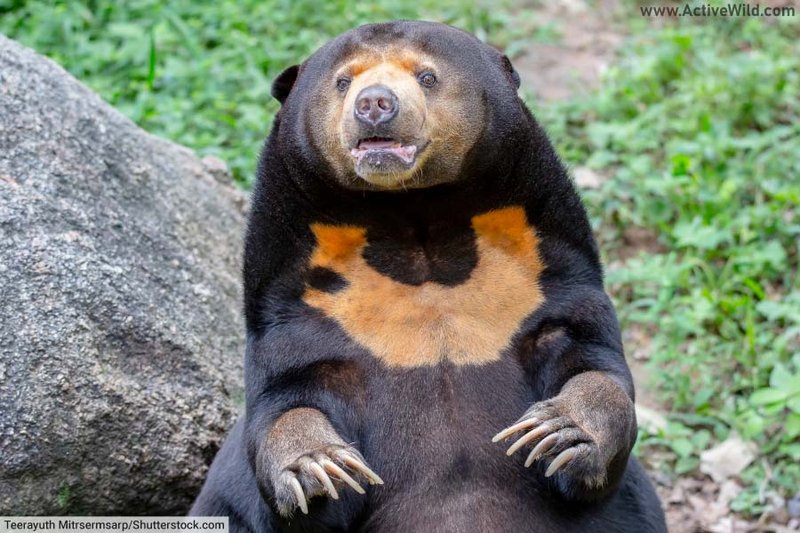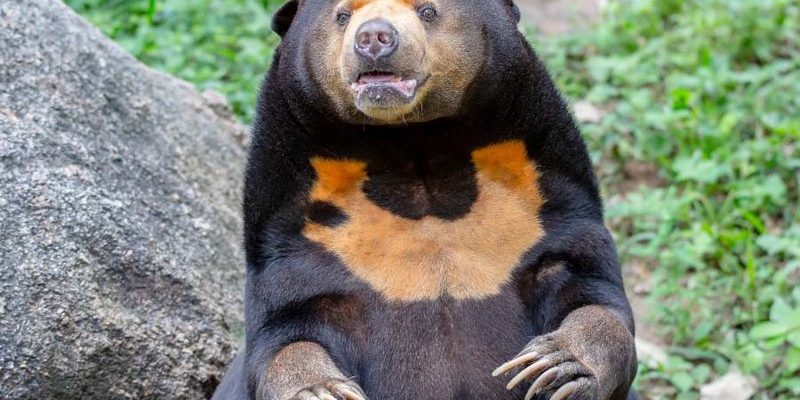
Exploring nature is like piecing together a giant puzzle. Each animal has its own special traits, helping us understand the amazing diversity of life around us. So, whether you’re a budding wildlife enthusiast or just someone who enjoys fun animal facts, let’s dive in. This guide will introduce you to ten animals that resemble the sun bear and highlight key features to help you tell them apart.
1. Sloth Bear
The sloth bear is a close relative of the sun bear, making it an interesting animal to compare. Native to the Indian subcontinent, sloth bears have a very similar body shape, with long limbs and a sleek build. One of their standout features is their shaggy, black fur, complemented by a distinctive white or yellowish V-shaped mark on their chest.
How to tell them apart? While sun bears have short, sleek fur, sloth bears have longer, more unkempt coats, which can get matted with dirt. Additionally, sloth bears have a more elongated snout and a more pronounced, shaggy mane around their face, giving them a grizzled appearance.
2. Asiatic Black Bear
Next up is the Asiatic black bear, also known as the moon bear. These bears inhabit forests across Asia, including China and India. Like sun bears, they have a stocky build, but they are generally larger. Their fur is thick and glossy, often appearing jet black with a prominent white crescent on their chest.
So, what sets them apart? The Asiatic black bear is significantly larger than the sun bear, which usually weighs between 60 to 150 pounds. They have larger, more rounded ears and longer, more powerful limbs, making them excellent climbers. Plus, their face has a distinctive look with a more robust snout.
3. Spectacled Bear
The spectacled bear is South America’s only bear species and shares a few similarities with the sun bear. Named for the unique markings around their eyes, which resemble spectacles, these bears have a generally stocky frame and a dark coat.
However, you might notice a few key differences. Spectacled bears often have lighter brown or reddish hues, especially on their chest and face. Unlike the sun bear, which has a short snout, the spectacled bear has a more elongated face, giving it a distinct appearance. Moreover, they are much larger, weighing up to 350 pounds!
4. Giant Panda
When we think of bears, the giant panda often comes to mind. Though they look quite different, every bear species shares some common ancestry. Pandas have a more robust and rotund body, covered in black and white fur, which is strikingly different from the sun bear’s shades.
Still, they have playful personalities like sun bears. How do you tell them apart? Pandas have a rounder face, larger body size (often around 250 pounds), and their famous black patches around the eyes. Their diet is also more specialized, primarily consisting of bamboo unlike the omnivorous sun bear.
5. Black Bear
The American black bear is another species worth mentioning in this comparison. Found across North America, black bears come in various colors—often black, but sometimes brown or even blond. Physically, they share a similar body shape with sun bears, being stocky yet agile.
However, black bears are generally larger, weighing between 150 to 600 pounds. Their fur is longer and thicker, and they have a more pronounced snout. A quick way to distinguish them is by their ears; black bears have taller, more pointed ears compared to the sun bear’s rounded ones.
6. Red Panda
While they share the name “panda,” the red panda is quite different from the giant panda. This small mammal, native to the Himalayas and southwestern China, is not a bear but belongs to its own family. Red pandas have a round face with a panda-like expression and a bushy tail.
To differentiate them from sun bears, look at their size and fur. Red pandas are much smaller—about the size of a domestic cat—and have a reddish-brown coat with white markings on their face and legs. They also have a more elongated body with a bushy tail, which they use for balance in the trees.
7. Kermode Bear
The Kermode bear, also known as the spirit bear, is a rare subspecies of the American black bear found on the coast of British Columbia, Canada. What sets this bear apart is its striking white or cream-colored fur, a result of a recessive gene.
While Kermode bears share a similar body structure with sun bears, their coloration is the biggest giveaway. Plus, they tend to be larger, often around 200 to 300 pounds. When you see a Kermode bear, the first thing you might notice is its unique fur, making it stand out in its forest habitat.
8. Polar Bear
The polar bear is another fascinating bear species, primarily found in the Arctic regions. While they don’t closely resemble sun bears in color or habitat, they share some basic bear traits. Polar bears are massive—often weighing between 900 to 1,600 pounds—making them the largest bear species.
To tell them apart, look for their white or yellowish fur, which is thick and helps them blend into snowy environments. Polar bears also have a longer snout for hunting seals, quite different from the short snout of the sun bear. Their sheer size sets them apart immediately!
9. Grizzly Bear
Grizzly bears are another well-known species, mainly found in North America. These bears can be identified by their large size, strong build, and distinctive hump on their back, thanks to powerful muscles they use for digging and running.
You might be wondering how to tell them apart from sun bears. Grizzlies are generally much larger, with weights ranging from 300 to 800 pounds. They also have longer fur, often with a grizzled appearance due to lighter-tipped hairs. If you see a bear with a pronounced hump and a long snout, it’s likely a grizzly.
10. Asiatic Lion
Though it may seem like a stretch to include the Asiatic lion, they share a habitat with sun bears and are both fascinating wildlife. Asiatic lions, found primarily in the Gir Forest of India, are smaller than their African relatives but still measure up to 400 pounds.
When comparing them to sun bears, the first difference is their fur—lions have a glorious mane and a more robust body. They are also social animals, often living in prides, while sun bears are solitary. If you see a large feline lounging in the sun, it’s a lion, not a bear!
In conclusion, exploring these 10 animals similar to the sun bear opens up a window into the incredible diversity of the animal kingdom. Each species has its own unique traits that make it special and worth learning about. Whether you’re fascinated by the sun bear or curious about its relatives, understanding these distinctions can enrich your appreciation of wildlife. So next time you’re out in nature, keep an eye out for these fascinating creatures!

